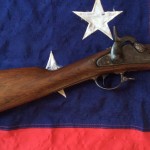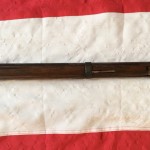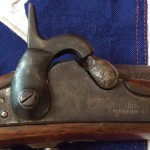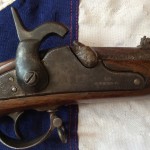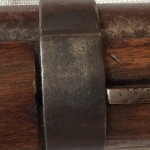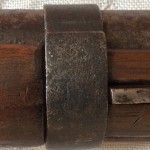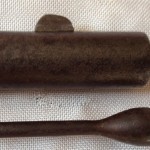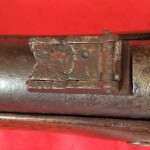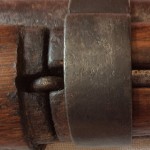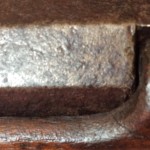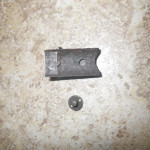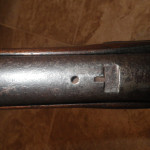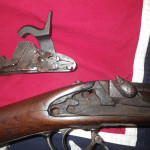- 1863 Richmond Short Rifle
- 1863 Richmond Short Rifle, Stock
- 1863 Richmind Short Rifle, Forward Stock
- 1863 Richmond Short Rifle, Lock Plate
- 1863 Richmond Short Rifle, Cocked Hammer
- Richmond Short Rifle, Rear Barrel Band
- Richmond Short Rifle, Forward Barrel Band
- 1863 Richmond Short Rifle, Front Sight
- Richmond Short Rifle, Rear Sight
- Richmond Short Rifle, Split Stock
- Richmond Short Rifle, Proofs
- 1863 Richmond Short Rifle Rear Sight
- 1863 Richmond Short Rifle Exposed Rear Sight
- 1863 Richmond Short Rifle Expose Lock Plate View
The job of harvesting trees to make gun stocks, limber carriages and wagons was hard. These jobs were done by experienced lumber jacks, most of which had learned from their fathers. Unfortunately for the South most of these men were fighting the Yankees in one way or the other. I
When Captian Turner Ashby and Company raided the arsenal in Harpers Ferry in April of 1861 he managed to confiscate 1000’s of rifle stocks, most were 1st quality stocks that the Richmond Armory used to assemble rifles, however many were 2nd quality stocks that had defects of some sort and wouldn’t pass the quality inspection that qualified them to be issued.
Fast forward to 1863 when all the confiscated 1st quality rifle stocks had been used and the Richmond Armory could not get any black walnut wood from their suppliers, mostly in and around the Macon Georgia area. This created a big problem for the Confederacy, with no quality wood to make rifle stocks how would they continue to fight a war?
As mentioned earlier, Stonewall Jackson’s raid on the Arsenal in Harpers Ferry he confiscated 1000’s of rifle stocks which were used to make Richmond rifle muskets. But the 2nd quality stocks were not used due to their defects. Now the South was in a real jam, they were in desperate need of arms but they had no black walnut to make them with.
So they turned their attention to the 2nd quality stocks that were not perfect but better than nothing. Many of these stocks were splintered and cracked. Southern cavalry troops were in desperate need of carbines and short rifles. By this time the Northern cavalry was armed with breech loading carbines that could be loaded quickly and shoot accurately some were issued Spencer carbines that could hold up to 7 brass cartridges which made them great assets for Cavalrymen.
The Richmond Armory with their master mechanics were forced to make rifles from damaged and broken stocks. Many of these weapons will be assembled using hardware from Union weapons that were found on battlefields.
That brings us to the next example in the Civil War Arsenal. This 1863 Richmond Virginia Short Rifle is made from a mix of old Union parts and Southern parts. Categorized in Paul J. Davies book, “C.S. Armory Richmond” as a Richmond Short Rifle (Old Parts) a total of 461 were made. In June of 1864, 261 short rifles were pieced together and in July of 1864, 200 short rifles were made. There were another 850 of these Short Rifles made categorized in Mr. Davies book as (New Parts) made with 1864 lock plates and brass/copper butt plates.
This Short Rifle has a split stock under the barrel band closest to the breech plug held together with an iron U shaped staple. Removing the lock plate shows the elimination of the primer feed for the Maynard Primer System this proves that this section of the stock is Southern made, or as I like to say “Southern Wood”. However the forward portion of the stock, beyond the stapled barrel band is from a Union Rifle with an iron stock tip and iron screw. The butt plate is iron without the U.S. stamp and the barrel bands do not have the usual U on them. The barrel measures 33” long with a pinched front sight and has the VP and eagle on the left side by the breech plug.
All in all this is a fine example of the resourcefulness of the South and a great piece of American history; I hope you enjoy the photos.
I buy Richmond carbines, short rifles, and rifled muskets as well as any and all parts regardless of condition. If you have any Richmond weapons or parts for sale please contact me at civilwararsenal@yahoo.com thanks for stopping by, Gene West


